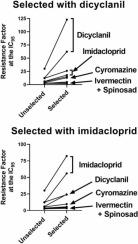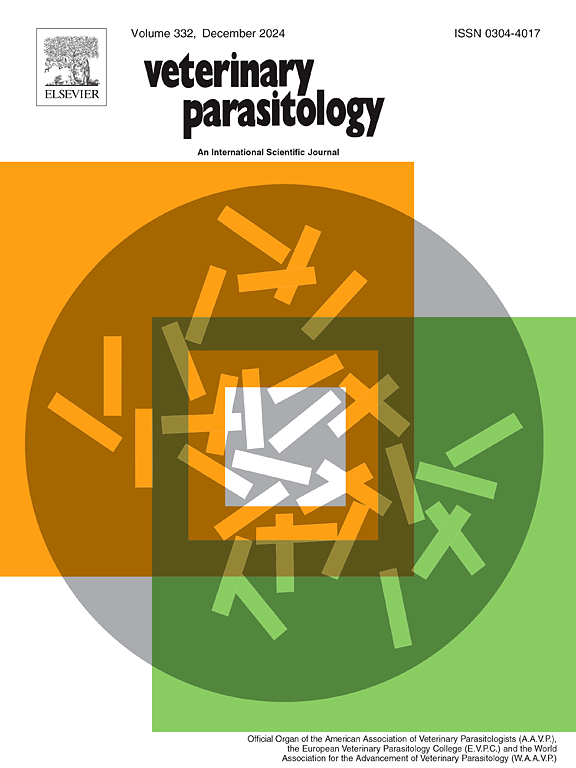在实验室选择压力下使用双氰胺或吡虫啉后,田间绵蚜虫株的交叉抗性模式。
IF 2
2区 农林科学
Q2 PARASITOLOGY
引用次数: 0
摘要
对羊吹蝇的控制主要依赖于在预期蝇类活动之前预防性使用杀虫剂。然而,羊吹已经显示出对某些杀虫剂产生抗药性的能力。最近有报告称,在体外生物测定中,田间采集的苍蝇菌株同时对双氰胺和吡虫啉产生了抗药性,这就提出了一种可能性,即这两种抗药性可能是由一种共同机制联系在一起的交叉抗药性。我们使用双氰胺或吡虫啉对两种对杀虫剂有抗性的田间品系的幼虫施加了杀虫剂选择压力,经过若干代后,测量了幼虫对选择化学药剂和替代化学药剂的敏感性变化,从而对这一问题进行了研究。使用每种化学品经过六代选择的幼虫对选择化学品的抗性显著增加:双环腈的抗性比 IC50 高 5.5 - 8.1 倍,吡虫啉的抗性比 IC50 高 3.1 - 3.8 倍。幼虫对另一种化学品的抗性水平也显著增加:在使用吡虫啉进行选择后,幼虫对双氰胺的抗性比率增加了 2.6 - 3.1 倍;在使用双氰胺进行选择后,幼虫对吡虫啉的抗性比率增加了 2.2 - 3.2 倍。暴露于这两种化学物质中的任何一种后,对它们的抗性都会增加,这表明至少在我们实验室选择的种群中存在一种共同的抗性机理。用细胞色素 P450 抑制剂氨基苯骈三氮唑进行的检测表明,这种增效剂能够消除用其中任何一种化合物筛选出的菌株对这两种化合物增加的抗药性,这表明细胞色素 P450 是导致对这两种化学品产生抗药性的原因。我们的研究结果证实,双氰胺和吡虫啉在羊吹螨中存在交叉抗药性,因此在飞虱控制的杀虫剂轮换策略中应将这两种化合物视为相关实体。本文章由计算机程序翻译,如有差异,请以英文原文为准。

Cross-resistance patterns in field strains of the sheep blowfly following laboratory-based selection pressure with dicyclanil or imidacloprid
Control of the sheep blowfly relies largely on the use of insecticides applied prophylactically in advance of expected fly activity. However, the blowfly has shown an ability to develop resistance to some of these insecticides. Recent reports of the co-occurrence of resistance to both dicyclanil and imidacloprid in in vitro bioassays with field-collected fly strains has raised the possibility that the two resistances may represent cross-resistance linked by a common mechanism. We investigated this by imposing insecticide selection pressure on larvae of two insecticide-resistant field strains over a number of generations using either dicyclanil or imidacloprid and then measuring changes in sensitivity to both the selecting chemical and the alternate chemical. Larvae selected over six generations with each chemical showed significant increases in resistance to the selecting chemical: resistance ratios at the IC50 5.5 - 8.1-fold higher for dicyclanil, and 3.1 - 3.8-fold for imidacloprid. The larvae also showed significant increases in levels of resistance towards the alternate chemical: resistance ratios 2.6 - 3.1-fold higher towards dicyclanil following selection with imidacloprid, and 2.2 - 3.2-fold higher towards imidacloprid following selection with dicyclanil. The increases in resistance to both chemicals after exposure to either suggests a common mechanism of resistance, at least in our laboratory-selected populations. Assays with the cytochrome P450 inhibitor aminobenzotriazole showed that this synergist was able to remove the increased resistance to both compounds in strains selected with either compound, suggesting that cytochrome P450 is responsible for the resistance observed to both chemicals. Our results confirm that cross-resistance exists between dicyclanil and imidacloprid in the sheep blowfly, and hence the two compounds should be considered as related entities in insecticide rotation strategies for flystrike control.
求助全文
通过发布文献求助,成功后即可免费获取论文全文。
去求助
来源期刊

Veterinary parasitology
农林科学-寄生虫学
CiteScore
5.30
自引率
7.70%
发文量
126
审稿时长
36 days
期刊介绍:
The journal Veterinary Parasitology has an open access mirror journal,Veterinary Parasitology: X, sharing the same aims and scope, editorial team, submission system and rigorous peer review.
This journal is concerned with those aspects of helminthology, protozoology and entomology which are of interest to animal health investigators, veterinary practitioners and others with a special interest in parasitology. Papers of the highest quality dealing with all aspects of disease prevention, pathology, treatment, epidemiology, and control of parasites in all domesticated animals, fall within the scope of the journal. Papers of geographically limited (local) interest which are not of interest to an international audience will not be accepted. Authors who submit papers based on local data will need to indicate why their paper is relevant to a broader readership.
Parasitological studies on laboratory animals fall within the scope of the journal only if they provide a reasonably close model of a disease of domestic animals. Additionally the journal will consider papers relating to wildlife species where they may act as disease reservoirs to domestic animals, or as a zoonotic reservoir. Case studies considered to be unique or of specific interest to the journal, will also be considered on occasions at the Editors'' discretion. Papers dealing exclusively with the taxonomy of parasites do not fall within the scope of the journal.
 求助内容:
求助内容: 应助结果提醒方式:
应助结果提醒方式:


